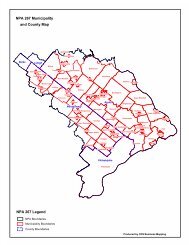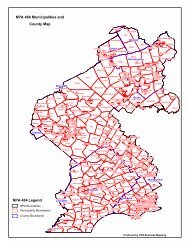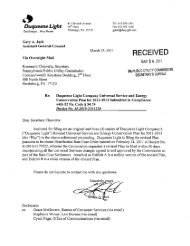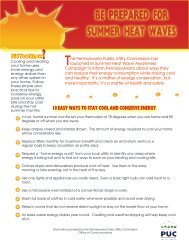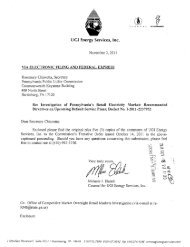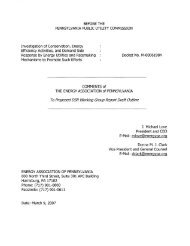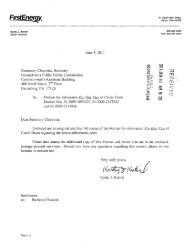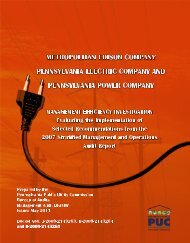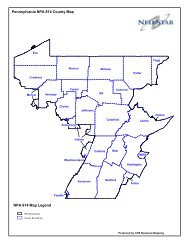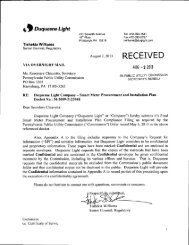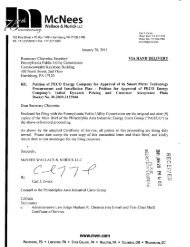2010 Report - Pennsylvania Public Utility Commission
2010 Report - Pennsylvania Public Utility Commission
2010 Report - Pennsylvania Public Utility Commission
You also want an ePaper? Increase the reach of your titles
YUMPU automatically turns print PDFs into web optimized ePapers that Google loves.
commercial (24.3 percent). Average annual use per residential customer was 11,446 kWh at anaverage cost of 8.37 cents per kWh; operating revenues totaled $1.37 billion.Between 1994 and 2009, West Penn's energy demand grew an average of 0.9 percent per year.Sales for all sectors have maintained relatively steady growth during the period, except for the lasttwo years. Residential sales grew at an annual rate of 1.1 percent and commercial sales grew at arate of 2.0 percent. Industrial sales declined at an average rate of 0.1 percent, due mainly to a 10.4percent drop in sales for 2009. The current five-year projection of growth in energy demand is 1.3percent. This includes a commercial rate of 1.7 percent and an industrial rate of 2.4 percent.Residential sales are expected to decline at an overall annual rate of 0.3 percent. See Figure 46.West Penn's 2009 summer peak load, occurring on Aug. 10, 2009, was 3,667 MW, representing adecrease of 4.1 percent from last year's summer peak of 3,823 MW. The 2009-10 winter peak loadwas 3,513 MW or 4.3 percent lower than the previous year's winter peak of 3,671 MW. The actualaverage annual peak load growth rate over the past 15 years was 1.0 percent. West Penn's loadforecast scenario shows the peak load increasing from 3,667 MW in the summer of 2009 to 3,951MW in 2014, or an average annual growth rate of 1.5 percent. The current forecast for <strong>2010</strong> is 202MW or 5.1 percent lower than the previous forecast. See Figure 47.Figure 48 depicts the average of deviations in forecasts made one to three years in advance. TablesA25-A28 in Appendix A provide West Penn’s forecasts of peak load and residential, commercialand industrial energy demand, filed with the <strong>Commission</strong> in years 2000 through <strong>2010</strong>.In April 2002, Allegheny Power joined PJM Interconnection. As a PJM member, AlleghenyPower is responsible for following the reliability standards of the PJM markets. The company hasaccess to an increased amount of energy resources within the expanded PJM market. West Pennremains an EDC, providing transmission and distribution service to its customers and providingPOLR service for those customers who do not choose an alternate supplier. Effective Nov. 18,1999, West Penn transferred all of its remaining generation assets to its affiliate, Allegheny EnergySupply Company, LLC.In 2009, West Penn purchased 987 GWh from cogeneration and independent power productionfacilities, or 4.7 percent of net energy for load. Contract capacity for these facilities was 136 MW.West Penn and its affiliate, TrAILCo, have identified several transmission line projects underconstruction or planned from <strong>2010</strong> through 2015 totaling 190 miles of 138 kV and 500 kV circuitsat an estimated cost of $140.8 million.West Penn’s Energy Efficiency & Conservation Plan 64 includes 22 energy efficiency and demandresponse programs which are estimated to meet or exceed the reduction targets of 628 GWh and157 MW at a total cost of $94.2 million.West Penn is a member of PJM and RFC.64 Docket No. M-2009-2093218.52<strong>Pennsylvania</strong> <strong>Public</strong> <strong>Utility</strong> <strong>Commission</strong>



